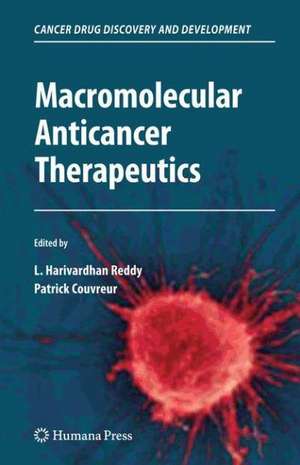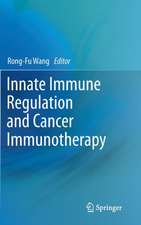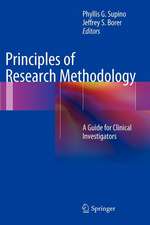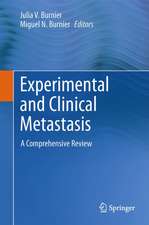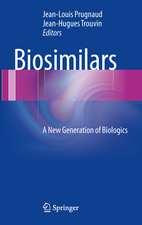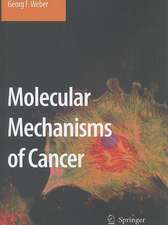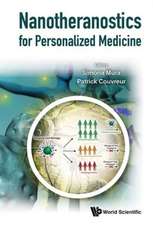Macromolecular Anticancer Therapeutics: Cancer Drug Discovery and Development
Editat de L. Harivardhan Reddy, Patrick Couvreuren Limba Engleză Hardback – 12 noi 2009
This book is unique and assembles various types and aspects of macromolecular anticancer therapeutics for cancer therapy in one shell and conveys the importance of this interdisciplinary field to the broad audience. Thus, in a nutshell, this book details the basics of cancer, and various therapeutic strategies such as those based on macromolecular therapeutics hence can become an important reference for practitioners, oncologists, medical pharmacologists, medicinal chemists, biomedical scientists, experimental pharmacologists, pharmaceutical technologists, and particularly it can essentially become a handbook of macromolecular therapeutics for cancer therapy for graduates, post-graduates and Ph.D. students in these fields.
| Toate formatele și edițiile | Preț | Express |
|---|---|---|
| Paperback (1) | 1807.25 lei 6-8 săpt. | |
| Springer – 3 mar 2012 | 1807.25 lei 6-8 săpt. | |
| Hardback (1) | 1939.63 lei 6-8 săpt. | |
| Springer – 12 noi 2009 | 1939.63 lei 6-8 săpt. |
Din seria Cancer Drug Discovery and Development
- 5%
 Preț: 1474.98 lei
Preț: 1474.98 lei - 5%
 Preț: 1108.35 lei
Preț: 1108.35 lei - 5%
 Preț: 1415.75 lei
Preț: 1415.75 lei - 5%
 Preț: 1370.19 lei
Preț: 1370.19 lei - 5%
 Preț: 1452.28 lei
Preț: 1452.28 lei - 5%
 Preț: 1316.74 lei
Preț: 1316.74 lei - 5%
 Preț: 1439.50 lei
Preț: 1439.50 lei - 5%
 Preț: 1113.63 lei
Preț: 1113.63 lei - 5%
 Preț: 1126.24 lei
Preț: 1126.24 lei - 24%
 Preț: 1037.59 lei
Preț: 1037.59 lei - 5%
 Preț: 1466.37 lei
Preț: 1466.37 lei - 5%
 Preț: 1350.78 lei
Preț: 1350.78 lei - 5%
 Preț: 1417.54 lei
Preț: 1417.54 lei - 5%
 Preț: 1113.46 lei
Preț: 1113.46 lei - 5%
 Preț: 1428.54 lei
Preț: 1428.54 lei - 5%
 Preț: 1429.80 lei
Preț: 1429.80 lei - 5%
 Preț: 782.10 lei
Preț: 782.10 lei - 5%
 Preț: 1438.58 lei
Preț: 1438.58 lei - 5%
 Preț: 1110.32 lei
Preț: 1110.32 lei - 5%
 Preț: 1434.39 lei
Preț: 1434.39 lei - 5%
 Preț: 1365.82 lei
Preț: 1365.82 lei - 5%
 Preț: 1461.08 lei
Preț: 1461.08 lei - 5%
 Preț: 1106.86 lei
Preț: 1106.86 lei - 5%
 Preț: 982.18 lei
Preț: 982.18 lei - 5%
 Preț: 727.80 lei
Preț: 727.80 lei - 5%
 Preț: 1331.76 lei
Preț: 1331.76 lei - 5%
 Preț: 1297.40 lei
Preț: 1297.40 lei - 5%
 Preț: 1124.59 lei
Preț: 1124.59 lei - 5%
 Preț: 1433.10 lei
Preț: 1433.10 lei - 5%
 Preț: 1110.90 lei
Preț: 1110.90 lei - 5%
 Preț: 1317.76 lei
Preț: 1317.76 lei - 5%
 Preț: 1464.91 lei
Preț: 1464.91 lei - 5%
 Preț: 1418.48 lei
Preț: 1418.48 lei - 5%
 Preț: 1438.94 lei
Preț: 1438.94 lei - 5%
 Preț: 1100.30 lei
Preț: 1100.30 lei - 5%
 Preț: 1109.96 lei
Preț: 1109.96 lei - 5%
 Preț: 990.58 lei
Preț: 990.58 lei - 5%
 Preț: 1443.13 lei
Preț: 1443.13 lei - 5%
 Preț: 1428.91 lei
Preț: 1428.91 lei - 5%
 Preț: 787.58 lei
Preț: 787.58 lei - 5%
 Preț: 1311.72 lei
Preț: 1311.72 lei - 5%
 Preț: 1331.76 lei
Preț: 1331.76 lei - 5%
 Preț: 1113.11 lei
Preț: 1113.11 lei - 5%
 Preț: 1440.76 lei
Preț: 1440.76 lei
Preț: 1939.63 lei
Preț vechi: 2041.71 lei
-5% Nou
Puncte Express: 2909
Preț estimativ în valută:
371.14€ • 388.55$ • 307.10£
371.14€ • 388.55$ • 307.10£
Carte tipărită la comandă
Livrare economică 05-19 aprilie
Preluare comenzi: 021 569.72.76
Specificații
ISBN-13: 9781441905062
ISBN-10: 1441905065
Pagini: 350
Ilustrații: X, 500 p. 50 illus., 8 illus. in color.
Dimensiuni: 155 x 235 x 44 mm
Greutate: 1.04 kg
Ediția:2010
Editura: Springer
Colecția Humana
Seria Cancer Drug Discovery and Development
Locul publicării:New York, NY, United States
ISBN-10: 1441905065
Pagini: 350
Ilustrații: X, 500 p. 50 illus., 8 illus. in color.
Dimensiuni: 155 x 235 x 44 mm
Greutate: 1.04 kg
Ediția:2010
Editura: Springer
Colecția Humana
Seria Cancer Drug Discovery and Development
Locul publicării:New York, NY, United States
Public țintă
Professional/practitionerCuprins
Chapter 1. Classification of anticancer drugs based on therapeutic targets
Enrique Espinosa, César Gómez Raposo
Section
Contents
Abstract
1
Introduction
2
Drugs directed against tumour dna
2.1
Drugs directly affecting DNA helix: alkylators
2.2
Inhibitors of DNA-related proteins
2.2.1
Topoisomerases inhibitors
2.2.2
Antimetabolites
2.2.3
Histone related enzymes
2.2.4
Inhibitors of transcription factors
2.3
Specific genes
3
Drugs directed against tumour RNA
4
Drugs directed against proteins in the tumour cell
4.1
Receptors in the tumour membrane
4.2
Intracellular pathways in tumour cells
4.3
Tubulin
5
Drugs acting on the endothelium
5.1
Inhibition of pro-angiogenic factors
5.2
Inhibition of vascular receptors
5.3
Inside the endothelium
6
Drugs directed against extracellular matrix
6.1
Matrix metalloproteinases inhibitors
6.2
Anti-integrin therapy
6.3
Copper chelators
6.4
L1-CAM protein
6.5
Thrombospondin and others
7
Immunotherapy
7.1
Antibody-based immunotherapy of cancer
7.1.1
Unconjugated monoclonal antibodies
7.1.2
Conjugated monoclonal antibodies
7.1.3
Monoclonal antibodies as immunogens
7.2
Cytokines in cancer immunotherapy
7.3
Cancer vaccines
7.3.1
Peptide vaccines
7.3.2
Dendritic cell-based cancer vaccines
7.3.3
Cellular vaccines
7.3.4
DNA vaccines
7.3.5
Heat shock protein vaccines
7.4
Adoptive TCell transfer for cancer immunotherapy
7.5
Natural killer cell-based immunotherapy
7.6
Regulatory cells and cancer immunotherapy
7.7
Toll-like receptors
8
Drugs acting on potentially metastatic sites and glands
9
Conclusion
References
Figure legends
Tables
Chapter 2. Signal transduction pathways as therapeutic targets in cancer therapy
Michele Milella, Ludovica Ciuffreda, Emilio Bria
Section
Contents
Abstract
1
Introduction
2
Protein tyrosine kinases (TK) as therapeutic targets
2.1
RTK as therapeutic targets: the paradigm of EGFR mutations in NSCLC
3
Cytoplasmic signaling intermediates
3.1
The Ras/Raf/MAPK pathway
3.2
The PI3K/AKT/mTOR pathway
3.3
Signaling crosstalk
4
Oncogenic addiction
4.1
Oncogenic shock
4.2
Oncogene amnesia
5
Open issues in the clinical development of signal transduction-targeted anticancer agents
5.1
The role of ‘early phases’: are phase II studies still necessary?
5.2
Phase II randomized studies: a new tale with targeted agents
5.3
Targeted agents: moving into phase III
Chapter 3. HPMA-anticancer drug conjugates
Rihova B, Hovorka O, Kovar L, Kovar M, Mrkvan T, Sirova M, Ulbrich K
Section
Contents
Abstract
1.
Introduction
2.
Synthesis and structure of N-(2-hydroxypropyl)methacrylamide copolymer-drug conjugates
2.1
Synthesis of linear polymer-drug conjugates
2.2
Polymer conjugates with biologically activeproteins
2.3
Polymer systems designed for targeted drug delivery
2.3.1
Passively targeted HPMA copolymer-drug conjugates
2.3.1.1
Branched and grafted high-molecular-weight HPMA copolymer conjugates
2.3.1.2
Self-assembled and micellar structures
2.3.2
Actively targeted HPMA copolymer-drug conjugates
2.3.2.1
Antibody-targeted HPMA copolymer conjugates
2.3.2.2
Lectin -targeted HPMA copolymer conjugates
2.3.2.3
Oligopeptide-targeted HPMA copolymer conjugates
2.3.2.4
HPMA copolymer conjugates targeted with other low-molecular weight moieties
3.
Immunogenicity of HPMA-based conjugates
3.1
The humoral response against HPMA
3.2
The cellular response to HPMA
3.3
Complement activation
3.4
The chronic treatment
3.5
The decreased immunogenicity of proteins bound to HPMA
3.6
Decrease of side toxicity of HPMA-copolymer carrier bound drugs
4.
HPMA copolymer–doxorubicin conjugates with pH-controlled activation
4.1
Linear Dox-HPMAHYD conjugates
4.2
Branched and grafted Dox-HPMAHYD conjugates
4.3
Micellar Dox-HPMAHYD conjugates
4.4
Antibody-targeted Dox-HPMAHYD conjugates
4.5
Immunomodulatory properties of Dox-HPMAHYD conjugates
5.
HPMA copolymer doxorubicin conjugates with amide bond between the drug and carrier
5.1
Dox-HPMAAM (PK1)
5.2
Dox-HPMAAM conjugate containing human immunoglobulin (HuIg)
5.2.1
Preclinical evaluation of Dox-HPMAAM-HuIg
5.2.2
Pilot clinical study with Dox-HPMAAM-HuIg
5.3
HPMA-based polymer prodrugs in clinicaltrials
6.
Specific targeting of HPMA copolymer-bound drug conjugates to cancer cells
6.1
Targeting to asialoglycoprotein receptor
6.2
Targeting using lectins
6.3
Targeting using antibodies
6.4
Targeting to transferrin receptor
6.5
Targeting using synthetic peptides
7.
Intracellular destiny of polymeric conjugates based on HPMA
7.1
Lysosomotropic delivery of the polymeric drugs
7.2
Intracellular destiny of polymeric drugs
7.3
Effect of a doxorubicin derivative 7,8-dehydro-9,10-desacetyldoxorubicinone (D*) in the detection of fluorescence
7.4
The cleavability of conjugates
7.5
Apoptosis, necrosis and cell signalling
8.
Immunomodulatory properties of HPMA copolymer-bound doxorubicin
Chapter 4. Poly-L-Glutamic acid anti-cancer drug conjugates
Jack W. Singer, Marc McKennon, Gabriella Pezzoni, Stefano di Giovine, Mara Cassin, Paola de Feudis, Cecilia Allievi, Patrizia Angiuli, Marco Natangelo, Enrico Vezzali, and Stefano Fazioni
Section
Contents
Abstract
1.
Introduction
2.
CT-2103 (Paclitaxel Poliglumex)
2.1
Chemistry and Manufacturing
2.1.1.
Technical Issues in the synthesis of CT-2103
2.1.2.
Synthetic strategy
2.1.3.
Synthesis Optimization
2.1.4.
Formulation of CT-2103
2.1.5.
Development of analytic methods and characterization of CT-2103
2.1.6.
Setting molecular weight and loading limits, the four corners approach
2.2.
Preclinical Pharmacology
2.2.1.
Pharmacokinetics
2.2.2.
Tissue distribution in rats and dogs
2.2.3.
Tissue distribution in comparison with paclitaxel in tumor bearing mice:
2.2.4.
Mass balance in rat
2.2.5.
Toxicology studies
2.3.
Cellular pharmacology
2.3.1.
Cellular Metabolism
2.3.2.
The role of the macrophage
2.3.3.
Preclinical efficacy
2.3.4.
In vivo efficacy studies in combination with radiation
2.3.5.
The effect of estradiol on CT-2103
2.4.
Preclinical Summary
2.5.
Clinical studies
2.5.1.
Phase I Studies: Determination of a safe and effective dose
2.5.2.
Phase II Studies
2.6.
Use of CT-2103 as a radiosensitizer
2.7.
Phase III Programs
2.7.1
Non-small cell lung cancer (NSCLC)
2.7.2.
Ovarian Cancer
3.
CT-2106 (poly-L-glutamic acid gly-camptothecin)
3.1.
Design and Synthesis
3.2.
Overview of preclinical studies
3.3.
Phase I Clinical Studies
Chapter 5. Polysaccharide-based anticancer prodrugs
Paolo Caliceti, Stefano Salmaso and Sara Bersani
Section
Contents
Abstract
1.
Introduction
2.
Chitin and Chitosan
2.1
Mitomycin C
2.1.1
Insoluble Suc-Chitosan-MMC derivatives
2.1.2
Soluble MMC-Suc-Chitosan derivatives
2.1.3
Lactosyl-Suc-Chitosan-MMC derivatives
2.2
Epirubcin
2.3
Doxorubicin
2.4
1-ß -D-arabinofuranosylcytosine
2.5
5-fluorouracil
2.6
Tyr-Ile-Gly-Ser-Arg
2.7
DNA
3.
Hyaluronic Acid
3.1
Paclitaxel
3.2
Doxorubicin
3.3
Butyric acid
3.4
All-Trans RetinoicAcid
4.
Dextran
4.1
Doxorubicin
4.2
Daunomycin
4.3
Adriamycin
4.4
Mitomycin C
4.5
Paclitaxel
4.6
1-ß-D-arabinofuranosylcytosine
4.7
Cisplatin
4.8
Camptothecin
4.9
Methylprednisolone and Tacrolimus
4.10
Radionuclides
4.11
Proteins
5.
Arabinogalactan
6.
Pullulan
7.
Cyclodextrins
Chapter 6. PEG-anticancer drugs
Francesca Cateni, Marina Zacchigna
Section
Contents
Abstract
1
Introduction
1.1
Drug delivery using permanent PEGylation
1.2
Non permanently bonded PEG-drugs: PEG prodrugs
2
PEG-anticancer prodrugs
2.1
PEG-Paclitaxel
2.2
PEG-Camptothecin
2.3
PEG-Doxorubicin
2.4
PEG-Daunorubucin
2.5
PEG-Epirubicin
2.6
PEG-Ara-C
2.7
PEG-Gemcitabine
2.8
PEG-Platinum drugs
2.9
PEG-Methotrexate
Chapter 7. Poly(ethylene glycol)-protein, peptide and enzyme conjugates
F.M.Veronese, G. Pasut, S.Drioli and G.M.Bonora
Section
Contents
Abstract
1
Introduction
2
PEG-proteins and peptides
2.1
Antibodies and antibody fragments
2.2
Granulocyte colony-stimulating factor
2.3
Interferons
2.4
Thrombopoietin or megakaryocyte growth and development factor
2.5
Anti-cancer peptides
3
PEG-enzymes
3.1
Arginase
3.2
Argininedeiminase
3.3
Asparaginase
3.4
Methioninase
3.5
Glutaminase
3.6
Uricase
3.7
Other anti-cancer enzymes
Chapter 8. Lipid-based anticancer prodrugs
L. Harivardhan Reddy and Patrick Couvreur
S. No.
Contents
1
Introduction
2
Lipids applied in cancer treatment
2.1
Non-fatty acids
2.1.1
Cardiolipin
2.1.2
Ceramide
2.2
Fatty acids
2.2.1
Essential fatty acids (EFAs)
2.2.2
Omega-3 fatty acids
2.2.3
Conjugated Linoleic acids
2.2.4
Olive oil constituent
2.2.4.1
Oleic acid
2.2.4.2
Elaidic acid
2.2.4.3
Squalene
2.2.5
Miscellaneous fatty acids
2.2.5.1
Valproic acid
2.2.5.2
Butyrates
3
Anticancer lipid prodrugs
3.1
Antibiotic anticancer drug-lipid conjugates
3.1.1
Mitomycin C-lipid conjugates
3.1.2
Doxorubicin-lipid conjugates
3.2
Antimetabolite anticancer drug-lipid conjugates
3.2.1
Methotrexate-lipid conjugates
3.2.2
Nucleoside analogue anticancer drug-lipid conjugates
3.2.2.1
Ara C-lipid conjugates
3.2.2.2
Gemcitabine-lipid conjugates
3.2.2.3
Troxacitabine-lipid conjugates
3.3
Taxane-lipid conjugates
3.4
Others: Camptothecin alkaloids-lipid conjugates
Chapter 9. Antibody-Cytotoxic Compound Conjugates for Oncology
Carol A. Vater and Victor S. Goldmacher
Section
Contents
Abstract
1
Introduction
2
Target selection
3
Antibody selection
4
Cytotoxic compounds used in Antibody-Cytotoxic compound Conjugates (ACCs1)
5
Antibody-cytotoxic compound linker strategies
6
ACCs in clinical development
7
Conclusions and future prospects
Chapter 10. Immunoconjugate anticancer therapeutics
Serengulam V. Govindan and David M. Goldenberg
Section
Contents
Abstract
1.
Introduction
2.
mAb forms for conjugates
2.1
Radionuclide conjugates
2.1.1
Radionuclides for RAIT
2.1.2
Therapy of hematological cancers
2.1.3
Therapy of solid cancers
2.1.3.1
As an adjuvant
2.1.3.2
Combination therapy
2.1.3.3
Locoregional application
2.1.3.4
Pretargeting
2.1.4
Quo vadis?
2.2
Antibody-drug conjugates
2.2.1
Drugs
2.2.2
Cleavable linker in drug conjugate design
2.2.2.1
Hydrazone-containing conjugates
2.2.2.2
Disulfide-containing conjugates
2.2.2.3
Conjugates with a cleavable-peptide
2.2.2.4
Ester linker
2.2.3
MAb conjugates: Homogeneity and site-specificity
2.3
Toxin conjugates
2.3.1
Plant and bacterial toxin conjugates
2.3.2
Ribonuclease conjugates
Conclusions
Chapter 11. Antibody directed enzyme prodrug therapy (ADEPT) for cancer
Surinder K Sharma and Kenneth D Bagshawe
Section
Contents
Abstract
1.
Introduction and Principles
2.
Antibodies and targets
3.
Enzymes
3.1
Mammalian enzymes including human
3.2
Non-mammalian enzymes
3.3
Catalytic Antibodies
4.
Prodrugs
5.
Carboxypeptidase G2
5.1
Antibody-Enzyme conjugates
5.1.1
Pre-Clinical Studies
5.1.2
Clinical studies
5.2
Fusion Proteins
6.
Immunogenicity
Conclusion
Chapter 12. EGFR-directed monoclonal antibodies
Roberto Bianco, Teresa Gelardi, Sonia Garofalo, Roberta Rosa, Giampaolo Tortora
Section
Contents
Abstract
1.
EGFR and cancer
2.
EGFR inhibitors as anticancer therapy
3.
Anti-EGFR monoclonal antibodies (MAbs)
3.1.
Cetuximab (IMC-225)
3.2.
Panitumumab (ABX-EGF)
3.3.
Matuzumab (EMD72000)
3.4.
Nimotuzumab (hR3)
3.5.
Zalutumumab
3.6.
MDX-447
3.7.
ch806
Conclusion
Chapter 13. The Biology of the HER Family and Her2/neu Directed-Antibody
Jennifer K. Litton and Gabriel N. Hortobagyi
Section
Contents
Abstract
1.
Introduction
2.
The HER Family
3.
HER2 and Downstream Signaling Pathways
3.1
The PI3k/Akt/mammalian target of rapamycin (mTOR) Pathway
3.2
HER2 and PTEN
3.3
The Ras/Raf/mitogen-activated protein kinase (MAPK) Pathway
3.4
HER2 and Endocrine Receptors (ER)
3.5
HER2 and p27
4.
HER2 Targeted Antibodies
4.1
Trastuzumab
4.1.1
Trastuzumab and Metastatic Breast Cancer: single agent trastuzumab
4.1.2
Dosing of Trastuzumab
4.1.3
Trastuzumab and Chemotherapy for Metastatic Breast Cancer
4.1.4
Trastuzumab and Aromatase Inhibitors for Metastatic Breast Cancer
4.1.5
Trastuzumab and Adjuvant Therapy
4.1.6
Trastuzumab and Neoadjuvant Chemotherapy
4.1.7
Treating with Trastuzumab Beyond Progression
4.1.8
Trastuzumab and Cardiotoxicity
4.1.9
Mechanisms of Resistance
4.2
HER and PTEN/PI3k/Akt/mammalian target of rapamycin (mTOR) Pathway
4.3
Insulin-like growth factor-1 receptor
4.4
MUC4 Over-expression
4.5
HER2 Receptor truncation or mutations
5.
Novel HER Family-directed antibodies
5.1
Pertuzumab
5.2
Trastuzumab-DM1
5.3
HER2 monoclonal antibodies and nanoparticles in development:
Conclusion
Chapter 14. Anti-Vascular Endothelial Growth Factor Monoclonal Antibodies
Ernest S. Han and Bradley J. Monk
S. No.
Contents
Abstract
1.1
Angiogenesis and Cancer
1.1.1
Biologic relevance of vascular endothelial growth factor in tumor angiogenesis
1.1.2
VEGF family and receptors
1.1.3
VEGF as a target for cancer therapy
1.2
VEGF Monoclonal antibodies and clinical experience
1.2.1
Bevacizumab
1.2.1.1
Pharmacology
1.2.1.2
Clinical experience
1.2.1.3
Side effects
1.2.2
VEGF Trap
1.2.2.1
Pharmacology
1.2.2.2
Clinical experience
1.2.3
HuMV833
1.2.3.1
Pharmacology
1.2.3.2
Clinical experience
1.3
VEGF receptor monoclonal antibodies
1.3.1
IMC-1121b
1.3.2
IMC-18F1
1.3.3
CDP791
1.4
Monoclonal antibodies to placental growth factor
<1.5 Current issues emerging from anti-VEGF therapies
1.5.1
Biologic markers for dosing and efficacy
1.5.2
Resistance to Anti-VEGF therapy
1.6
Summary
Chapter 15. Monoclonal Antibody Therapy for Hematologic Malignancies
Kenneth A. Foon, Michael Boyiadzis, Samuel A. Jacobs
Section
Contents
Abstract
1.
Introduction
2.
Rituximab
2.1
Follicular Lymphoma
2.2
Marginal Zone B-Cell Lymphoma
2.3
Mantle Cell Lymphoma
2.4
Diffuse Large B-Cell Lymphoma
2.5
Chronic Lymphocytic Leukemia/Small Lymphocytic Lymphoma
3.
90Y Ibritumomab Tiuxetan
4.
131I tositumomab
5.
Alemtuzumab
6.
Gemtuzumab Ozogamicin
7.
Ofatumumab
8.
AME-133v
9.
Epratuzumab
10.
CMC-544
11.
BL22
12.
Lumiliximab
13.
Galiximab
14.
SGN-40
15.
Bevacizumab
16.
CP-751,871
17.
Zanolimumab
18.
Limtuzumab
19.
IMC-EB10
20.
SGN-30
21.
Chimeric Anti-CD4 Monoclonal Antibody
22.
TRU-016
23.
Milatuzumab
24.
Ipilimumab
Conclusion
Chapter 16. Anticancer oligonucleotides
Anne Laure Ramon and Claude Malvy
Section
Contents
1.
Introduction
2.
Pre-clinical studies
2.1
Antisense oligonucleotides
2.1.1
Studies on bcl-2 proto oncogene
2.1.2
Studies on Raf kinases
2.1.3
Studies on Ras proteins
2.1.4
Studies on PKC-a
2.2
Small interfering RNA
2.2.1
Studies on bcl-2 proto oncogene
2.2.2
Studies on Raf kinases
2.2.3
Studies on Ras proteins and PKC-a
2.3
Decoys
2.4
Aptamers
2.5
Ribozymes
2.5.1
Studies on bcl-2
2.5.2
Studies on Ras proteins
2.5.3
Studies on PKC-a
2.6
Discussion
2.6.1
Immunostimulation
2.6.2
Minimal active doses
2.6.3
Selectivity and off-target effects
3.
Clinical studies
3.1
Antisense oligonucleotides
3.1.1
Clinical trials on Bcl-2
3.1.2
Clinical trials on Raf kinase
3.1.3
Clinical trials on Ras
3.1.4
Clinical trials on PKC-a
3.2
Small interfering RNA
3.3
Ribozymes
3.4
Decoys
3.5
Discussion
4.
Conclusion
Chapter 17. New molecular therapeutic interventions: the case of breast cancers
Véronique Marsaud and Jack-Michel Renoir
Section
Contents
Abstract
1.
Introduction
2.
2. Estrogens, phytoestrogens and xenoestrogens
2.1
Biosynthesis of estrogens
2.2
Phytoestrogens and xenoestrogens
3.
Estrogen receptors
3.1
Structure
3.2
The classical genomic transactivation mechanisms
3.3.
Non-classical transactivation systems
3.4
Nuclear localization and nucleo-cytoplasmic shuttling
3.5
Estrogen receptors stability
4.
Estrogen Receptors in Breast cancers
4.1
Estrogen receptors in the normal mammary gland
4.1.1
Estrogen receptor isotypes in breastcancers
4.1.2.
Classical anti-hormonal treatments
4.1.2.1
SERDs and SERDs
4.1.2.2
Aromatase inhibitors
4.1.2.3
Resistance
5.
Emergence of innovative strategies for specific targets
5.1
Apoptosis induction and Cell cycle inhibition
5.1.1
Apoptosis
5.1.2
Cdk inhibitors
5.1.3
Survivin
5.1.4
Nuclear factor-k B
5.1.5
Ubiquitine-proteasome system
5.1.6
Histone deacetylase inhibitors
5.1.7
Hsp90 inhibitors
5.1.8
p53
5.1.9
Pi3K/Akt pathway
5.1.10
Farnesyl transferase inhibitors (FTI)
5.2
Vascular and angiogenesis inhibitors
5.3
Monoclonal antibodies and tyrosine kinase inhibitors for EGFR and Erb-B2
6.
Breast cancer and stem cells
6. 1.
Implication of stem cells in metastasis
6.2.
Targeting CD44 for breast cancer therapy
7.
Conclusion and future perspectives
Enrique Espinosa, César Gómez Raposo
Section
Contents
Abstract
1
Introduction
2
Drugs directed against tumour dna
2.1
Drugs directly affecting DNA helix: alkylators
2.2
Inhibitors of DNA-related proteins
2.2.1
Topoisomerases inhibitors
2.2.2
Antimetabolites
2.2.3
Histone related enzymes
2.2.4
Inhibitors of transcription factors
2.3
Specific genes
3
Drugs directed against tumour RNA
4
Drugs directed against proteins in the tumour cell
4.1
Receptors in the tumour membrane
4.2
Intracellular pathways in tumour cells
4.3
Tubulin
5
Drugs acting on the endothelium
5.1
Inhibition of pro-angiogenic factors
5.2
Inhibition of vascular receptors
5.3
Inside the endothelium
6
Drugs directed against extracellular matrix
6.1
Matrix metalloproteinases inhibitors
6.2
Anti-integrin therapy
6.3
Copper chelators
6.4
L1-CAM protein
6.5
Thrombospondin and others
7
Immunotherapy
7.1
Antibody-based immunotherapy of cancer
7.1.1
Unconjugated monoclonal antibodies
7.1.2
Conjugated monoclonal antibodies
7.1.3
Monoclonal antibodies as immunogens
7.2
Cytokines in cancer immunotherapy
7.3
Cancer vaccines
7.3.1
Peptide vaccines
7.3.2
Dendritic cell-based cancer vaccines
7.3.3
Cellular vaccines
7.3.4
DNA vaccines
7.3.5
Heat shock protein vaccines
7.4
Adoptive TCell transfer for cancer immunotherapy
7.5
Natural killer cell-based immunotherapy
7.6
Regulatory cells and cancer immunotherapy
7.7
Toll-like receptors
8
Drugs acting on potentially metastatic sites and glands
9
Conclusion
References
Figure legends
Tables
Chapter 2. Signal transduction pathways as therapeutic targets in cancer therapy
Michele Milella, Ludovica Ciuffreda, Emilio Bria
Section
Contents
Abstract
1
Introduction
2
Protein tyrosine kinases (TK) as therapeutic targets
2.1
RTK as therapeutic targets: the paradigm of EGFR mutations in NSCLC
3
Cytoplasmic signaling intermediates
3.1
The Ras/Raf/MAPK pathway
3.2
The PI3K/AKT/mTOR pathway
3.3
Signaling crosstalk
4
Oncogenic addiction
4.1
Oncogenic shock
4.2
Oncogene amnesia
5
Open issues in the clinical development of signal transduction-targeted anticancer agents
5.1
The role of ‘early phases’: are phase II studies still necessary?
5.2
Phase II randomized studies: a new tale with targeted agents
5.3
Targeted agents: moving into phase III
Chapter 3. HPMA-anticancer drug conjugates
Rihova B, Hovorka O, Kovar L, Kovar M, Mrkvan T, Sirova M, Ulbrich K
Section
Contents
Abstract
1.
Introduction
2.
Synthesis and structure of N-(2-hydroxypropyl)methacrylamide copolymer-drug conjugates
2.1
Synthesis of linear polymer-drug conjugates
2.2
Polymer conjugates with biologically activeproteins
2.3
Polymer systems designed for targeted drug delivery
2.3.1
Passively targeted HPMA copolymer-drug conjugates
2.3.1.1
Branched and grafted high-molecular-weight HPMA copolymer conjugates
2.3.1.2
Self-assembled and micellar structures
2.3.2
Actively targeted HPMA copolymer-drug conjugates
2.3.2.1
Antibody-targeted HPMA copolymer conjugates
2.3.2.2
Lectin -targeted HPMA copolymer conjugates
2.3.2.3
Oligopeptide-targeted HPMA copolymer conjugates
2.3.2.4
HPMA copolymer conjugates targeted with other low-molecular weight moieties
3.
Immunogenicity of HPMA-based conjugates
3.1
The humoral response against HPMA
3.2
The cellular response to HPMA
3.3
Complement activation
3.4
The chronic treatment
3.5
The decreased immunogenicity of proteins bound to HPMA
3.6
Decrease of side toxicity of HPMA-copolymer carrier bound drugs
4.
HPMA copolymer–doxorubicin conjugates with pH-controlled activation
4.1
Linear Dox-HPMAHYD conjugates
4.2
Branched and grafted Dox-HPMAHYD conjugates
4.3
Micellar Dox-HPMAHYD conjugates
4.4
Antibody-targeted Dox-HPMAHYD conjugates
4.5
Immunomodulatory properties of Dox-HPMAHYD conjugates
5.
HPMA copolymer doxorubicin conjugates with amide bond between the drug and carrier
5.1
Dox-HPMAAM (PK1)
5.2
Dox-HPMAAM conjugate containing human immunoglobulin (HuIg)
5.2.1
Preclinical evaluation of Dox-HPMAAM-HuIg
5.2.2
Pilot clinical study with Dox-HPMAAM-HuIg
5.3
HPMA-based polymer prodrugs in clinicaltrials
6.
Specific targeting of HPMA copolymer-bound drug conjugates to cancer cells
6.1
Targeting to asialoglycoprotein receptor
6.2
Targeting using lectins
6.3
Targeting using antibodies
6.4
Targeting to transferrin receptor
6.5
Targeting using synthetic peptides
7.
Intracellular destiny of polymeric conjugates based on HPMA
7.1
Lysosomotropic delivery of the polymeric drugs
7.2
Intracellular destiny of polymeric drugs
7.3
Effect of a doxorubicin derivative 7,8-dehydro-9,10-desacetyldoxorubicinone (D*) in the detection of fluorescence
7.4
The cleavability of conjugates
7.5
Apoptosis, necrosis and cell signalling
8.
Immunomodulatory properties of HPMA copolymer-bound doxorubicin
Chapter 4. Poly-L-Glutamic acid anti-cancer drug conjugates
Jack W. Singer, Marc McKennon, Gabriella Pezzoni, Stefano di Giovine, Mara Cassin, Paola de Feudis, Cecilia Allievi, Patrizia Angiuli, Marco Natangelo, Enrico Vezzali, and Stefano Fazioni
Section
Contents
Abstract
1.
Introduction
2.
CT-2103 (Paclitaxel Poliglumex)
2.1
Chemistry and Manufacturing
2.1.1.
Technical Issues in the synthesis of CT-2103
2.1.2.
Synthetic strategy
2.1.3.
Synthesis Optimization
2.1.4.
Formulation of CT-2103
2.1.5.
Development of analytic methods and characterization of CT-2103
2.1.6.
Setting molecular weight and loading limits, the four corners approach
2.2.
Preclinical Pharmacology
2.2.1.
Pharmacokinetics
2.2.2.
Tissue distribution in rats and dogs
2.2.3.
Tissue distribution in comparison with paclitaxel in tumor bearing mice:
2.2.4.
Mass balance in rat
2.2.5.
Toxicology studies
2.3.
Cellular pharmacology
2.3.1.
Cellular Metabolism
2.3.2.
The role of the macrophage
2.3.3.
Preclinical efficacy
2.3.4.
In vivo efficacy studies in combination with radiation
2.3.5.
The effect of estradiol on CT-2103
2.4.
Preclinical Summary
2.5.
Clinical studies
2.5.1.
Phase I Studies: Determination of a safe and effective dose
2.5.2.
Phase II Studies
2.6.
Use of CT-2103 as a radiosensitizer
2.7.
Phase III Programs
2.7.1
Non-small cell lung cancer (NSCLC)
2.7.2.
Ovarian Cancer
3.
CT-2106 (poly-L-glutamic acid gly-camptothecin)
3.1.
Design and Synthesis
3.2.
Overview of preclinical studies
3.3.
Phase I Clinical Studies
Chapter 5. Polysaccharide-based anticancer prodrugs
Paolo Caliceti, Stefano Salmaso and Sara Bersani
Section
Contents
Abstract
1.
Introduction
2.
Chitin and Chitosan
2.1
Mitomycin C
2.1.1
Insoluble Suc-Chitosan-MMC derivatives
2.1.2
Soluble MMC-Suc-Chitosan derivatives
2.1.3
Lactosyl-Suc-Chitosan-MMC derivatives
2.2
Epirubcin
2.3
Doxorubicin
2.4
1-ß -D-arabinofuranosylcytosine
2.5
5-fluorouracil
2.6
Tyr-Ile-Gly-Ser-Arg
2.7
DNA
3.
Hyaluronic Acid
3.1
Paclitaxel
3.2
Doxorubicin
3.3
Butyric acid
3.4
All-Trans RetinoicAcid
4.
Dextran
4.1
Doxorubicin
4.2
Daunomycin
4.3
Adriamycin
4.4
Mitomycin C
4.5
Paclitaxel
4.6
1-ß-D-arabinofuranosylcytosine
4.7
Cisplatin
4.8
Camptothecin
4.9
Methylprednisolone and Tacrolimus
4.10
Radionuclides
4.11
Proteins
5.
Arabinogalactan
6.
Pullulan
7.
Cyclodextrins
Chapter 6. PEG-anticancer drugs
Francesca Cateni, Marina Zacchigna
Section
Contents
Abstract
1
Introduction
1.1
Drug delivery using permanent PEGylation
1.2
Non permanently bonded PEG-drugs: PEG prodrugs
2
PEG-anticancer prodrugs
2.1
PEG-Paclitaxel
2.2
PEG-Camptothecin
2.3
PEG-Doxorubicin
2.4
PEG-Daunorubucin
2.5
PEG-Epirubicin
2.6
PEG-Ara-C
2.7
PEG-Gemcitabine
2.8
PEG-Platinum drugs
2.9
PEG-Methotrexate
Chapter 7. Poly(ethylene glycol)-protein, peptide and enzyme conjugates
F.M.Veronese, G. Pasut, S.Drioli and G.M.Bonora
Section
Contents
Abstract
1
Introduction
2
PEG-proteins and peptides
2.1
Antibodies and antibody fragments
2.2
Granulocyte colony-stimulating factor
2.3
Interferons
2.4
Thrombopoietin or megakaryocyte growth and development factor
2.5
Anti-cancer peptides
3
PEG-enzymes
3.1
Arginase
3.2
Argininedeiminase
3.3
Asparaginase
3.4
Methioninase
3.5
Glutaminase
3.6
Uricase
3.7
Other anti-cancer enzymes
Chapter 8. Lipid-based anticancer prodrugs
L. Harivardhan Reddy and Patrick Couvreur
S. No.
Contents
1
Introduction
2
Lipids applied in cancer treatment
2.1
Non-fatty acids
2.1.1
Cardiolipin
2.1.2
Ceramide
2.2
Fatty acids
2.2.1
Essential fatty acids (EFAs)
2.2.2
Omega-3 fatty acids
2.2.3
Conjugated Linoleic acids
2.2.4
Olive oil constituent
2.2.4.1
Oleic acid
2.2.4.2
Elaidic acid
2.2.4.3
Squalene
2.2.5
Miscellaneous fatty acids
2.2.5.1
Valproic acid
2.2.5.2
Butyrates
3
Anticancer lipid prodrugs
3.1
Antibiotic anticancer drug-lipid conjugates
3.1.1
Mitomycin C-lipid conjugates
3.1.2
Doxorubicin-lipid conjugates
3.2
Antimetabolite anticancer drug-lipid conjugates
3.2.1
Methotrexate-lipid conjugates
3.2.2
Nucleoside analogue anticancer drug-lipid conjugates
3.2.2.1
Ara C-lipid conjugates
3.2.2.2
Gemcitabine-lipid conjugates
3.2.2.3
Troxacitabine-lipid conjugates
3.3
Taxane-lipid conjugates
3.4
Others: Camptothecin alkaloids-lipid conjugates
Chapter 9. Antibody-Cytotoxic Compound Conjugates for Oncology
Carol A. Vater and Victor S. Goldmacher
Section
Contents
Abstract
1
Introduction
2
Target selection
3
Antibody selection
4
Cytotoxic compounds used in Antibody-Cytotoxic compound Conjugates (ACCs1)
5
Antibody-cytotoxic compound linker strategies
6
ACCs in clinical development
7
Conclusions and future prospects
Chapter 10. Immunoconjugate anticancer therapeutics
Serengulam V. Govindan and David M. Goldenberg
Section
Contents
Abstract
1.
Introduction
2.
mAb forms for conjugates
2.1
Radionuclide conjugates
2.1.1
Radionuclides for RAIT
2.1.2
Therapy of hematological cancers
2.1.3
Therapy of solid cancers
2.1.3.1
As an adjuvant
2.1.3.2
Combination therapy
2.1.3.3
Locoregional application
2.1.3.4
Pretargeting
2.1.4
Quo vadis?
2.2
Antibody-drug conjugates
2.2.1
Drugs
2.2.2
Cleavable linker in drug conjugate design
2.2.2.1
Hydrazone-containing conjugates
2.2.2.2
Disulfide-containing conjugates
2.2.2.3
Conjugates with a cleavable-peptide
2.2.2.4
Ester linker
2.2.3
MAb conjugates: Homogeneity and site-specificity
2.3
Toxin conjugates
2.3.1
Plant and bacterial toxin conjugates
2.3.2
Ribonuclease conjugates
Conclusions
Chapter 11. Antibody directed enzyme prodrug therapy (ADEPT) for cancer
Surinder K Sharma and Kenneth D Bagshawe
Section
Contents
Abstract
1.
Introduction and Principles
2.
Antibodies and targets
3.
Enzymes
3.1
Mammalian enzymes including human
3.2
Non-mammalian enzymes
3.3
Catalytic Antibodies
4.
Prodrugs
5.
Carboxypeptidase G2
5.1
Antibody-Enzyme conjugates
5.1.1
Pre-Clinical Studies
5.1.2
Clinical studies
5.2
Fusion Proteins
6.
Immunogenicity
Conclusion
Chapter 12. EGFR-directed monoclonal antibodies
Roberto Bianco, Teresa Gelardi, Sonia Garofalo, Roberta Rosa, Giampaolo Tortora
Section
Contents
Abstract
1.
EGFR and cancer
2.
EGFR inhibitors as anticancer therapy
3.
Anti-EGFR monoclonal antibodies (MAbs)
3.1.
Cetuximab (IMC-225)
3.2.
Panitumumab (ABX-EGF)
3.3.
Matuzumab (EMD72000)
3.4.
Nimotuzumab (hR3)
3.5.
Zalutumumab
3.6.
MDX-447
3.7.
ch806
Conclusion
Chapter 13. The Biology of the HER Family and Her2/neu Directed-Antibody
Jennifer K. Litton and Gabriel N. Hortobagyi
Section
Contents
Abstract
1.
Introduction
2.
The HER Family
3.
HER2 and Downstream Signaling Pathways
3.1
The PI3k/Akt/mammalian target of rapamycin (mTOR) Pathway
3.2
HER2 and PTEN
3.3
The Ras/Raf/mitogen-activated protein kinase (MAPK) Pathway
3.4
HER2 and Endocrine Receptors (ER)
3.5
HER2 and p27
4.
HER2 Targeted Antibodies
4.1
Trastuzumab
4.1.1
Trastuzumab and Metastatic Breast Cancer: single agent trastuzumab
4.1.2
Dosing of Trastuzumab
4.1.3
Trastuzumab and Chemotherapy for Metastatic Breast Cancer
4.1.4
Trastuzumab and Aromatase Inhibitors for Metastatic Breast Cancer
4.1.5
Trastuzumab and Adjuvant Therapy
4.1.6
Trastuzumab and Neoadjuvant Chemotherapy
4.1.7
Treating with Trastuzumab Beyond Progression
4.1.8
Trastuzumab and Cardiotoxicity
4.1.9
Mechanisms of Resistance
4.2
HER and PTEN/PI3k/Akt/mammalian target of rapamycin (mTOR) Pathway
4.3
Insulin-like growth factor-1 receptor
4.4
MUC4 Over-expression
4.5
HER2 Receptor truncation or mutations
5.
Novel HER Family-directed antibodies
5.1
Pertuzumab
5.2
Trastuzumab-DM1
5.3
HER2 monoclonal antibodies and nanoparticles in development:
Conclusion
Chapter 14. Anti-Vascular Endothelial Growth Factor Monoclonal Antibodies
Ernest S. Han and Bradley J. Monk
S. No.
Contents
Abstract
1.1
Angiogenesis and Cancer
1.1.1
Biologic relevance of vascular endothelial growth factor in tumor angiogenesis
1.1.2
VEGF family and receptors
1.1.3
VEGF as a target for cancer therapy
1.2
VEGF Monoclonal antibodies and clinical experience
1.2.1
Bevacizumab
1.2.1.1
Pharmacology
1.2.1.2
Clinical experience
1.2.1.3
Side effects
1.2.2
VEGF Trap
1.2.2.1
Pharmacology
1.2.2.2
Clinical experience
1.2.3
HuMV833
1.2.3.1
Pharmacology
1.2.3.2
Clinical experience
1.3
VEGF receptor monoclonal antibodies
1.3.1
IMC-1121b
1.3.2
IMC-18F1
1.3.3
CDP791
1.4
Monoclonal antibodies to placental growth factor
<1.5 Current issues emerging from anti-VEGF therapies
1.5.1
Biologic markers for dosing and efficacy
1.5.2
Resistance to Anti-VEGF therapy
1.6
Summary
Chapter 15. Monoclonal Antibody Therapy for Hematologic Malignancies
Kenneth A. Foon, Michael Boyiadzis, Samuel A. Jacobs
Section
Contents
Abstract
1.
Introduction
2.
Rituximab
2.1
Follicular Lymphoma
2.2
Marginal Zone B-Cell Lymphoma
2.3
Mantle Cell Lymphoma
2.4
Diffuse Large B-Cell Lymphoma
2.5
Chronic Lymphocytic Leukemia/Small Lymphocytic Lymphoma
3.
90Y Ibritumomab Tiuxetan
4.
131I tositumomab
5.
Alemtuzumab
6.
Gemtuzumab Ozogamicin
7.
Ofatumumab
8.
AME-133v
9.
Epratuzumab
10.
CMC-544
11.
BL22
12.
Lumiliximab
13.
Galiximab
14.
SGN-40
15.
Bevacizumab
16.
CP-751,871
17.
Zanolimumab
18.
Limtuzumab
19.
IMC-EB10
20.
SGN-30
21.
Chimeric Anti-CD4 Monoclonal Antibody
22.
TRU-016
23.
Milatuzumab
24.
Ipilimumab
Conclusion
Chapter 16. Anticancer oligonucleotides
Anne Laure Ramon and Claude Malvy
Section
Contents
1.
Introduction
2.
Pre-clinical studies
2.1
Antisense oligonucleotides
2.1.1
Studies on bcl-2 proto oncogene
2.1.2
Studies on Raf kinases
2.1.3
Studies on Ras proteins
2.1.4
Studies on PKC-a
2.2
Small interfering RNA
2.2.1
Studies on bcl-2 proto oncogene
2.2.2
Studies on Raf kinases
2.2.3
Studies on Ras proteins and PKC-a
2.3
Decoys
2.4
Aptamers
2.5
Ribozymes
2.5.1
Studies on bcl-2
2.5.2
Studies on Ras proteins
2.5.3
Studies on PKC-a
2.6
Discussion
2.6.1
Immunostimulation
2.6.2
Minimal active doses
2.6.3
Selectivity and off-target effects
3.
Clinical studies
3.1
Antisense oligonucleotides
3.1.1
Clinical trials on Bcl-2
3.1.2
Clinical trials on Raf kinase
3.1.3
Clinical trials on Ras
3.1.4
Clinical trials on PKC-a
3.2
Small interfering RNA
3.3
Ribozymes
3.4
Decoys
3.5
Discussion
4.
Conclusion
Chapter 17. New molecular therapeutic interventions: the case of breast cancers
Véronique Marsaud and Jack-Michel Renoir
Section
Contents
Abstract
1.
Introduction
2.
2. Estrogens, phytoestrogens and xenoestrogens
2.1
Biosynthesis of estrogens
2.2
Phytoestrogens and xenoestrogens
3.
Estrogen receptors
3.1
Structure
3.2
The classical genomic transactivation mechanisms
3.3.
Non-classical transactivation systems
3.4
Nuclear localization and nucleo-cytoplasmic shuttling
3.5
Estrogen receptors stability
4.
Estrogen Receptors in Breast cancers
4.1
Estrogen receptors in the normal mammary gland
4.1.1
Estrogen receptor isotypes in breastcancers
4.1.2.
Classical anti-hormonal treatments
4.1.2.1
SERDs and SERDs
4.1.2.2
Aromatase inhibitors
4.1.2.3
Resistance
5.
Emergence of innovative strategies for specific targets
5.1
Apoptosis induction and Cell cycle inhibition
5.1.1
Apoptosis
5.1.2
Cdk inhibitors
5.1.3
Survivin
5.1.4
Nuclear factor-k B
5.1.5
Ubiquitine-proteasome system
5.1.6
Histone deacetylase inhibitors
5.1.7
Hsp90 inhibitors
5.1.8
p53
5.1.9
Pi3K/Akt pathway
5.1.10
Farnesyl transferase inhibitors (FTI)
5.2
Vascular and angiogenesis inhibitors
5.3
Monoclonal antibodies and tyrosine kinase inhibitors for EGFR and Erb-B2
6.
Breast cancer and stem cells
6. 1.
Implication of stem cells in metastasis
6.2.
Targeting CD44 for breast cancer therapy
7.
Conclusion and future perspectives
Notă biografică
L. Harivardhan Reddy is Head of Nanovectors group at Sanofi-aventis, France. He completed Ph.D. in Pharmaceutics and Drug delivery in 2005 from The M.S. University of Baroda, India. He has worked for 4 years in two popular pharmaceutical companies (Sun Pharmaceutical Industries Ltd., and Aristo Pharmaceuticals Ltd.) in India, on drug delivery applications. He worked for 3 years (2005-2008) with anticancer drug delivery specialist Prof. Patrick Couvreur in CNRS lab at Université Paris-Sud, Chatenay-Malabry, France. He is an inventor of 3 patents belonging to macromolecular therapeutics and drug delivery. He has published, as an author and co-author, more than 60 publications in various reputed journals. He is also a reviewer for more than 15 journals of the fields of biomacromolecules, drug delivery, cancer therapy, and pharmacology. He is a member of The European Association for Cancer Research. His principal research interests are supramolecular lipidic prodrug nanomedicines and nanotherapeutics for cancer.
Patrick Couvreur is a Full Professor of Pharmacy at the University Paris-Sud, France, and holder of the chair of "Innovation Technologique" (2009-2010) at the prestigious ‘Collège de France’. He is a member of the Academy of Technologies (France), of the Academy of Pharmacy (France) and corresponding member of the Royal Academy of Medicine (Belgium). Prof. Patrick COUVREUR’s contributions in the field of drug delivery and targeting are highly recognized and respected around the world. Patrick COUVREUR performed a pioneer work together with Peter SPEISER, and demonstrated for the first time in 1977 that nanoparticles may be used as intracellular carriers for compounds which don’t diffuse spontaneously into cells. Patrick COUVREUR’s research is primarily on polymer-based and metallic-based nanomedicines, surface engineered nanosystems, and also focuses on lipid-based nanocarriers. He has publishedas an author and co-author, 341 publications, 109 review articles and book chapters, 6 books as editor, 50 patents, and 193 invited and plenary lectures at national and international congresses. He has received Pharmaceutical Sciences World Congress Award (2004), the "Marie-Maurice Janot Lecture" (2008) and above all the prestigious "Host Madsen Medal" (2007) in honour of his outstanding research achievements. He is a Field Editor of "Pharmaceutical Research", European Editor of the "Journal of Nanoparticles Research", and is a reviewer of more than 15 high reputed journals in the fields of Drug delivery, cancer research, macromolecules, physical chemistry etc. He is acting or acted as Board of Governors of the Controlled Release Society (CRS), Board of APGI, Expert Member of the Board of Pharmaceutical Sciences, International Pharmaceutical Federation (FIP). His exceptional research has led to two start-up companies BIOALLIANCE and MEDSQUAL dealing with novel therapeutics, in France.
Patrick Couvreur is a Full Professor of Pharmacy at the University Paris-Sud, France, and holder of the chair of "Innovation Technologique" (2009-2010) at the prestigious ‘Collège de France’. He is a member of the Academy of Technologies (France), of the Academy of Pharmacy (France) and corresponding member of the Royal Academy of Medicine (Belgium). Prof. Patrick COUVREUR’s contributions in the field of drug delivery and targeting are highly recognized and respected around the world. Patrick COUVREUR performed a pioneer work together with Peter SPEISER, and demonstrated for the first time in 1977 that nanoparticles may be used as intracellular carriers for compounds which don’t diffuse spontaneously into cells. Patrick COUVREUR’s research is primarily on polymer-based and metallic-based nanomedicines, surface engineered nanosystems, and also focuses on lipid-based nanocarriers. He has publishedas an author and co-author, 341 publications, 109 review articles and book chapters, 6 books as editor, 50 patents, and 193 invited and plenary lectures at national and international congresses. He has received Pharmaceutical Sciences World Congress Award (2004), the "Marie-Maurice Janot Lecture" (2008) and above all the prestigious "Host Madsen Medal" (2007) in honour of his outstanding research achievements. He is a Field Editor of "Pharmaceutical Research", European Editor of the "Journal of Nanoparticles Research", and is a reviewer of more than 15 high reputed journals in the fields of Drug delivery, cancer research, macromolecules, physical chemistry etc. He is acting or acted as Board of Governors of the Controlled Release Society (CRS), Board of APGI, Expert Member of the Board of Pharmaceutical Sciences, International Pharmaceutical Federation (FIP). His exceptional research has led to two start-up companies BIOALLIANCE and MEDSQUAL dealing with novel therapeutics, in France.
Textul de pe ultima copertă
The field of macromolecular therapeutics for cancer therapy is of considerable importance, as these therapeutic systems are gaining more and more interest to give new directions for the treatment of this dreadful disease. Macromolecular Anticancer Therapeutics, which describes in detail the macromolecular therapeutics for cancer therapy, covers the classification of these anticancer drugs based on therapeutic targets, and elaborates on different classes of anticancer therapeutics which are either in pre-clinic or in clinical phases or are already commercialized. This book also discusses various signal transduction pathways involved in the cancer growth and resistance to therapy, providing a clear insight into the molecular mechanistic aspects of this topic; it also describes the essential targets for efficient cancer therapy. In detail, this volume elaborates the different categories of macromolecular therapeutics of respectively natural and synthetic polymer and lipid origin, their chemistry, design and development, opportunities and challenges, current status, pre-clinic and clinical progresses. In addition, the design, development, and the challenges involved in future directions for cancer therapy using various categories of antibody-based therapeutics are elaborated in areas such as antibody-mediated drug targeting to cancer employing antibody-drug conjugates, radioimmunoconjugates, toxin-antibody conjugates, antibody-mediated enzyme pro-drug therapeutics, and also using antibodies alone to interfere with specific molecular targets responsible for tumor growth and progression. Besides the current status, pre-clinic and clinical progress of a variety of therapeutic anticancer oligonucleotides and siRNA designed and developed for specific inhibition of oncogenes are detailed. Furthermore, in this book, special attention is given to the treatment of breast cancer based on a comprehensive description about molecular mechanisms involved, hormone receptors implicated and molecular therapeutic interventions.
Macromolecular Anticancer Therapeutics details the current macromolecular therapeutic strategies, and should become an important reference for practitioners, oncologists, medical pharmacologists, medicinal chemists, biomedical scientists, experimental pharmacologists and pharmaceutical technologists. It is also a reference concerning macromolecular cancer therapy for graduates, post-graduates and Ph.D. students belonging to these fields.
Macromolecular Anticancer Therapeutics details the current macromolecular therapeutic strategies, and should become an important reference for practitioners, oncologists, medical pharmacologists, medicinal chemists, biomedical scientists, experimental pharmacologists and pharmaceutical technologists. It is also a reference concerning macromolecular cancer therapy for graduates, post-graduates and Ph.D. students belonging to these fields.
Caracteristici
Macromolecular anticancer therapeutics encompasses macromolecule-conjugated anticancer prodrugs or macromolecules themselves for the treatment of cancer Emphasizes various types and aspects of macromolecular anticancer therapeutics such as polymer-based anticancer therapeutics, antibody-directed anticancer therapeutics, lipid-based anticancer therapeutics and nucleic acid therapeutics (see table of contents) Various chapters in this book are to be written by pioneer scientists and experts in the respective fields Includes supplementary material: sn.pub/extras
